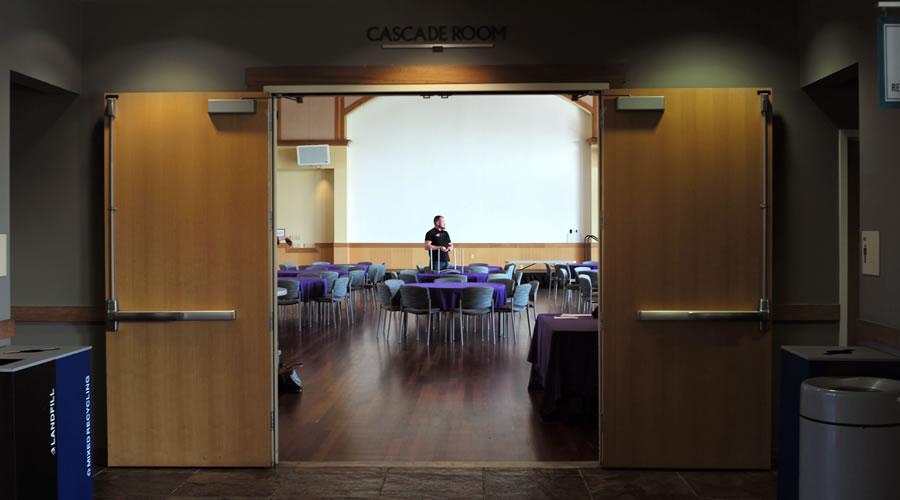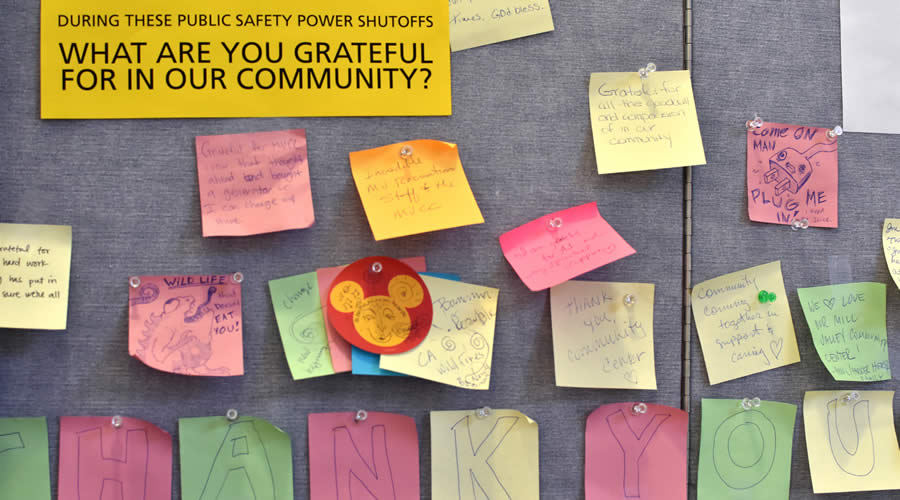California communities brace for more blackouts
From the agricultural Central Valley to beachy Santa Barbara, local leaders are doing their best to prepare for the worst.
In late October, as a second wave of massive power outages loomed over the San Francisco bedroom community of Mill Valley, Linn Walsh braced for the worst.
As the city’s senior management analyst, Walsh is a point person for emergency planning. As such, she’s at the bleeding edge of a new managerial challenge: figuring out how to keep critical services running, and support area families and businesses impacted by multi-day power outages.
The ongoing Public Safety Power Shutoffs—intentional blackouts that have lasted up to four days in some cases—are meant to prevent power lines from starting the type of wildfires that have devastated California over the last few years. But this attempt to protect the public has, in many ways, imperiled residents and businesses.
People with home medical devices or freezers full of insulin are scrambling to find help. Firefighters reliant on electric water pumps must come up with backup plans. Grocery chains that communities depend on close their doors and throw out hundreds of thousands of dollars’ worth of perishable goods. Factories must idle their lines and their workers. Even big box retail stores, which in the past could weather a day or two of closed doors, are facing four- and five-day outages that add up to significant losses in revenue.
It’s not just California. From the flood-deluged Southeast to snowstorm-prone New England, civic and business leaders are wondering how to ensure energy reliability and operational continuity in the face of climate change. Indeed, half of Fortune 500 CFOs say they now play a larger role in energy decisions than they did five years ago, according to a survey by Engie North America, which manages energy businesses in the U.S. and Canada.
“We’re all still digging out from this, but very few businesses are built for this sort of thing. The power outage comes at a great cost.”
The specter of a future with no power has them talking for the first time in generations about reliable power. And in many ways, Mill Valley, among the first in the path of the blackouts, offers a study for civic and business leaders.
Jim Welte, co-director of the Chamber of Commerce in Mill Valley, which is home to aerospace manufacturing, software design firms, big box retail, and grocery chains, characterizes the emotions from the area’s business leaders as ranging from “frustrated” to “livid.”
“We’re all still digging out from this,” says Welte of the outages, “but very few businesses are built for this sort of thing. The power outage comes at a great cost, and it comes with a great loss,” particularly when facing the prospect that outages could drag on for a decade.
Waiting for the dark
As soon as utilities announced in April they were considering what they call “proactive de-energization events,” Walsh and her team snapped into business strategy mode. “We started developing a playbook,” she says. “What essential services were we going to provide? How were we going to create power to provide them?”
Running a city is like running a large company: you need buy-in from every division. After months of meetings and emails with fire, police, sanitation, and wastewater departments, she came up with an action plan that provided the best energy resilience she could muster.
Mill Valley has solar panels on its community center and police and fire department buildings. But they’re useless during a utility power outage. That’s because the energy they produce flows into the electrical grid. The panels automatically shut off during an outage, to keep power from flowing onto power lines and potentially killing line workers.
Instead, the city would rely on a series of diesel generators, none of which had enough on-site fuel to last beyond 24 hours. “If it’s a really big [outage]” lasting up to five days, one council member warned, “you’re not going to be able to find fuel anymore, or a new generator.”
Without answers to those questions, Walsh was forced to put her plan into action on October 29, when a three-day blackout hit the city, its businesses, and its 14,000 residents.

Community Outlet: Mill Valley’s community center, powered by generators, remained open to 14,000 residents for hot showers and to charge their phones and laptops.
According to plan, four key facilities switched over to generators. City Hall’s generator, which can run 17 hours before refueling, powered critical services, such as supporting public safety. The police and emergency services building generator, which could last eight hours on a single tank, remained fully functioning and required multiple refills. Schools and libraries closed. Portable generators powered traffic lights at four critical intersections, making Mill Valley one of the only municipalities in the area that had functioning traffic signals.
Residents attempting to work brought laptops and even printers to the local Whole Foods and Mill Valley Market, which had generator backup, or drove south to San Francisco where they filled coffee shops and libraries, looking for electricity and a Wi-Fi signal. Residents needing hot showers flocked to the community center.
The city had, in anticipation of the outages, passed new rules to allow residents and businesses to run backup generators, which had been previously curtailed because of the loud noise and harmful particulate matter they emit. The new rules allow commercial generators to run 24 hours a day and homes to run from 7 a.m. to 9 p.m. Residents with electric-powered medical equipment can run generators 24 hours a day as well.
According to Walsh, it took a proverbial village to muddle through. “It’s frustrating to not have power and to have all your food spoil,” she says. “And a power outage can be life threatening if you have a medical device that relies on electricity.”

Writing on the Wall: It took a village to get through the three-day outage. “A power outage can be life threatening,” says Walsh, especially to those who rely on medical devices.
Who’s going to pay?
In October alone, California utilities initiated four major PSPSs—the largest of which impacted 1 million customers. Because each customer behind a single meter can represent families and businesses, experts estimate the shutoffs actually impacted 3 million people. In some cases, utilities took 90 hours to restore power to all those affected.
It’s not just an inconvenience. It’s a bottom line issue for businesses and working families.
Hourly employees can lose a week’s pay if a factory or grocery shuts down. People who work from home to earn a living can’t. And working parents have to stay home with kids when schools close. During the first major outage, on Oct. 7, Stanford University professor Michael Wara, using a widely accepted industry calculator, estimated the shutoff would cost residential customers $65 million. It would cost small commercial and industrial businesses, which predominate in the rural and suburban blackout zones, $2.4 billion.
Across the state, communities are finding many different ways to deal with the challenge. Counties as far apart and as different as San Joaquin in the agriculture-focused Central Valley to Santa Barbara in beachy Southern California, have developed readiness plans. In addition to warning about disruption to communications, water, and transportation, they advise people to stock up on gas (because gas stations may shut down), avoid elevators, and seek backup help if they are reliant on medical devices.

Mobile Response: Stanislaus County Deputy Sheriff Raj Singh helped run a mobile response unit for public health, police, and fire, and “addressed issues” as they arose.
Finding clean and resilient energy alternatives to the major utility grid is increasingly discussed across the state. The mayor of the city of San Jose, where 60,000 residents lost power recently, proposed starting its own utility, as has San Francisco.
As blackouts become more prevalent, C-suite business leaders are also increasingly turning to reliable alternatives to the grid, such as microgrids, which can operate alongside a main grid but independently of it during a power outage. These self-contained energy systems can provide always-on, resilient, cost-effective power. Among the most flexible and reliable are fuel cells, which use a chemical process to create energy from natural gas, biogas, and hydrogen. Because there’s no combustion involved, these fuel cells produce no harmful particulate matter and emit only a fraction of carbon that gas generators emit.
As Fortune 100 business leaders adopt fuel cells for reliable energy, community leaders are now calling for them, too. After a series of storms that dumped 20 inches of heavy snow on Connecticut in 2011, downing trees and power lines and leaving 750,000 people without power for up to 11 days, the city of Hartford decided to build a microgrid. Using solid oxide fuel cells, which during normal times are connected to the utility grid, the city can now power up five buildings—a school, community center, library, grocery store, and gas station—in a dense urban area where they can serve the community during outages.
See how Bloom Energy worked with the City of Hartford to build its microgrid
As an emergency manager, Mill Valley’s Walsh says her city might be interested in energy resilience in the future, and could “explore options such as microgrids,” given that the city “is often on the cutting edge of exploring new technologies.”
Until that happens—and until more communities find an always-on, reliable energy solution—they and local businesses are on the hook for the bills. None of the expenses they incur during the blackouts are reimbursable by the state or federal governments, or by insurance companies. That’s because intentional power shutoffs are “not considered an emergency,” Dana Carey, Yolo County Office of Emergency Services Manager, told her city council recently. “This is considered to be ‘normal operations’ now.”


